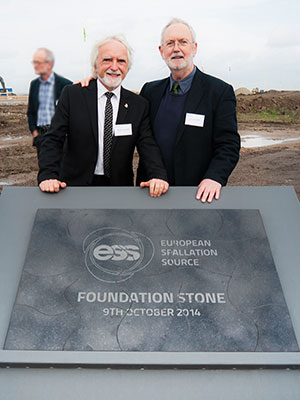Prof invited to foundation stone ceremony of €2bn science project
 Aerial view of the European Spallation Source (ESS) to be built at Lund in Sweden.
Aerial view of the European Spallation Source (ESS) to be built at Lund in Sweden.
Tue, 14 Oct 2014 14:20:00 BST
Professor Bob Cywinski attends ground-breaking ceremony of the European Spallation Source in Sweden
 UNIVERSITY of Huddersfield scientists have played important roles in the genesis of one of Europe’s most ambitious construction projects – an advanced neutron research facility. So they were represented when the foundation stone was ceremonially laid for the European Spallation Source (ESS)in Lund, Sweden.
UNIVERSITY of Huddersfield scientists have played important roles in the genesis of one of Europe’s most ambitious construction projects – an advanced neutron research facility. So they were represented when the foundation stone was ceremonially laid for the European Spallation Source (ESS)in Lund, Sweden.
The physicist Professor Robert Cywinski – currently Dean of the University’s Graduate School – was present at the event, alongside large numbers of other leading European scientists, as they celebrated the start of work on a two-billion euro “super microscope”, which will enable thousands of researchers to see and understand the atomic structure of materials.
The ESS will restore Europe’s lead in neutron beam science and its use of “spallation” – the process of deploying a particle accelerator to scatter or chip neutrons from a hard metal target – represents a major advance on the more usual nuclear reactor-based technology.
It is hoped that the first neutrons will be produced by 2019 and it is estimated that eventually some 3,000 scientists a year will use the ESS for research into fields that include computer components, fuel cells, textiles, medicines, transport, food technology, DNA and cosmetics.
Professor Cywinski’s contribution to the evolution of ESS has included a key role in spreading public awareness of the project. This included the production of a promotional movie fronted by the actor Sir Patrick Stewart, who is Chancellor of the University of Huddersfield.
During the lengthy process to find a location for ESS, Professor Cywinski was the prime advocate of a proposal that it should be built at a site near Selby in Yorkshire. Lund in Sweden was eventually chosen for the facility and Professor Cywinski, who was official spokesperson for the ESS during its preparatory phase, welcomed the announcement, commenting that “this is something we can focus on and move forward”.
Now he is delighted that construction work has begun and that he was able to take up an invitation to attend the foundation stone ceremony, marking the fruition of a project that Professor Cywinski can trace to the 1980s. Also present at the ceremony were the University of Huddersfield’s Professor Sue Kilcoyne, plus Professor Colin Carlile, a central figure in the development of the ESS who is the recipient of an honorary doctorate from Huddersfield.
Several of Professor Cywinski’s University of Huddersfield colleagues have also been closely involved in the development of the ESS. They include Professor Roger Barlow, Dr Cristian Bungau and Dr Adriana Bungau, who have carried out crucial calculations. It is hoped that there will be continued involvement in the design of instrumentation and the accelerators. Huddersfield’s Professor Rebecca Seviour spent a year in Lund seconded to the ESS project as a physicist, helping the development of the powerful ESS accelerator during its design phase.







